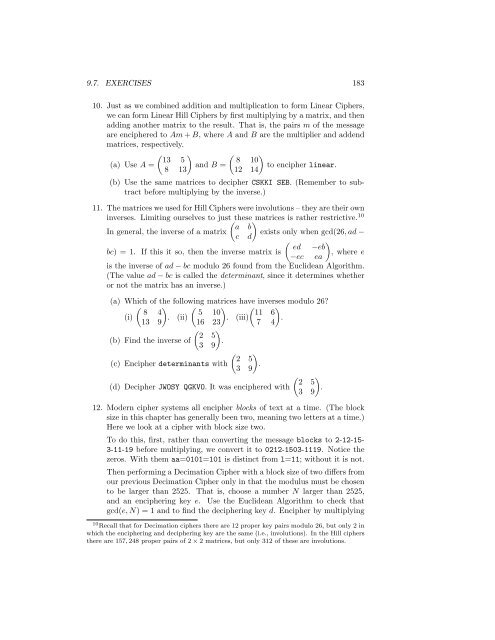Cryptology - Unofficial St. Mary's College of California Web Site
Cryptology - Unofficial St. Mary's College of California Web Site
Cryptology - Unofficial St. Mary's College of California Web Site
Create successful ePaper yourself
Turn your PDF publications into a flip-book with our unique Google optimized e-Paper software.
9.7. EXERCISES 183<br />
10. Just as we combined addition and multiplication to form Linear Ciphers,<br />
we can form Linear Hill Ciphers by first multiplying by a matrix, and then<br />
adding another matrix to the result. That is, the pairs m <strong>of</strong> the message<br />
are enciphered to Am + B, where A and B are the multiplier and addend<br />
matrices, respectively.<br />
(a) Use A =<br />
( 13 5<br />
8 13<br />
)<br />
and B =<br />
( ) 8 10<br />
to encipher linear.<br />
12 14<br />
(b) Use the same matrices to decipher CSKKI SEB. (Remember to subtract<br />
before multiplying by the inverse.)<br />
11. The matrices we used for Hill Ciphers were involutions – they are their own<br />
inverses. Limiting ourselves to just( these)<br />
matrices is rather restrictive. 10<br />
a b<br />
In general, the inverse <strong>of</strong> a matrix exists only when gcd(26, ad −<br />
c d<br />
( ) ed −eb<br />
bc) = 1. If this it so, then the inverse matrix is<br />
, where e<br />
−ec ea<br />
is the inverse <strong>of</strong> ad − bc modulo 26 found from the Euclidean Algorithm.<br />
(The value ad − bc is called the determinant, since it determines whether<br />
or not the matrix has an inverse.)<br />
(a) Which <strong>of</strong> the following matrices have inverses modulo 26<br />
( ) ( ) ( )<br />
8 4 5 10 11 6<br />
(i) . (ii) . (iii) .<br />
13 9 16 23 7 4<br />
( ) 2 5<br />
(b) Find the inverse <strong>of</strong> .<br />
3 9<br />
(c) Encipher determinants with<br />
( ) 2 5<br />
.<br />
3 9<br />
(d) Decipher JWOSY QGKVO. It was enciphered with<br />
( ) 2 5<br />
.<br />
3 9<br />
12. Modern cipher systems all encipher blocks <strong>of</strong> text at a time. (The block<br />
size in this chapter has generally been two, meaning two letters at a time.)<br />
Here we look at a cipher with block size two.<br />
To do this, first, rather than converting the message blocks to 2-12-15-<br />
3-11-19 before multiplying, we convert it to 0212-1503-1119. Notice the<br />
zeros. With them aa=0101=101 is distinct from l=11; without it is not.<br />
Then performing a Decimation Cipher with a block size <strong>of</strong> two differs from<br />
our previous Decimation Cipher only in that the modulus must be chosen<br />
to be larger than 2525. That is, choose a number N larger than 2525,<br />
and an enciphering key e. Use the Euclidean Algorithm to check that<br />
gcd(e, N) = 1 and to find the deciphering key d. Encipher by multiplying<br />
10 Recall that for Decimation ciphers there are 12 proper key pairs modulo 26, but only 2 in<br />
which the enciphering and deciphering key are the same (i.e., involutions). In the Hill ciphers<br />
there are 157, 248 proper pairs <strong>of</strong> 2 × 2 matrices, but only 312 <strong>of</strong> these are involutions.

















